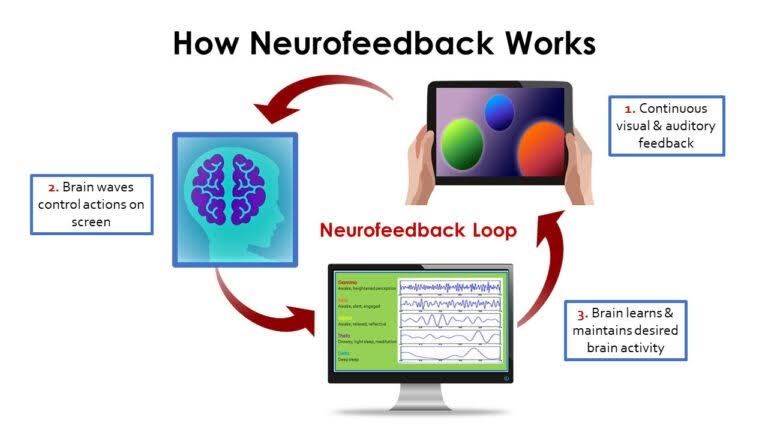Our Approach
Neurofeedback is akin to a workout for your brain. It allows the brain’s activity to be measured, in real time, and help your brain to be more consistent, or regulated, in what brain waves it is creating at any given time. This feedback is provided through visual and auditory modes and because it happens in real time, the brain is able to immediately learn how to develop regulation and consistency. This ultimately results in improved functioning, deceased symptoms, overall improved wellness, and the ability to manage more effectively, amongst other things.
We customize the experience for each person, focusing on specific brainwave frequencies and sensor locations to address each individual’s needs. The brain has an amazing ability to transform itself, known as neuroplasticity. Regardless of age, the brain can change with the right feedback. Just like exercise improves your muscles, neurofeedback is a powerful tool for exercising your brain. The amazing thing about neurofeedback is once your brain has made the changes they are essentially permanent!

Many people are looking for alternative interventions to help the brain remain healthy and functional throughout life. Neurofeedback is a non-invasive, non-medication intervention to promote brain health and wellness.
Are neurofeedback changes permanent?
The results from brain training with neurofeedback should be long-lasting for anyone, across any age range.
Factors that can impact whether the changes are maintained long-term include: the number of neurofeedback sessions, what the target of neurofeedback was, if new targets are identified, whether there are underlying untreated health issues, and future health issues such as a head injury. If someone has new injuries or stressors, booster neurofeedback sessions can be very helpful. Like having learned to ride a bike, even if you haven’t ridden for decades, your brain quickly remembers how to keep you steady and moving forward. Neurofeedback is similar in that it is a learned practice.
How safe is neurofeedback?
Decades of research show that neurofeedback is very safe, particularly when done with trained and experienced professionals. Side effects are rare and tend to be nothing more than mildly annoying. The most common side effects are fatigue and mild headache, typically when first starting neurofeedback. Think of this like when one first starts exercising. Your muscles are sore because they are not used to the activity. However, with consistency, the soreness lessens and soon isn’t an issue. Same thing is true with the side effects with neurofeedback…once the brain is used to training the side effects tend to go away. However, the vast majority of people who do neurofeedback never experience any side effects.
What can I expect from neurofeedback?
The number of sessions and timing of intervention are specific to the individual. In our program, sessions are scheduled twice a week for 45 minutes each session, with up to 30 minutes of direct training occurring during each session. You sit in a comfortable chair with one or two sensors (electrodes) on the scalp that monitor brain wave activity. Like a stethoscope allows us to hear the heartbeat, the sensors allow us to see brain activity. Also like a stethoscope, we are not able to put anything into the brain (i.e., electrical activity)…we can simply monitor the brainwave activity. While training, you watch a game that simulates your brain activity, as well as hear auditory cues. When your brain is creating adaptive, healthy patterns, the game progresses and the sound is heard. If it creates too much or too little of brainwave patterns that aren’t as functional, the game and sound stops. The brain learns to create more of what it should and less of what it shouldn’t over time resulting in improved functioning and observable changes.

